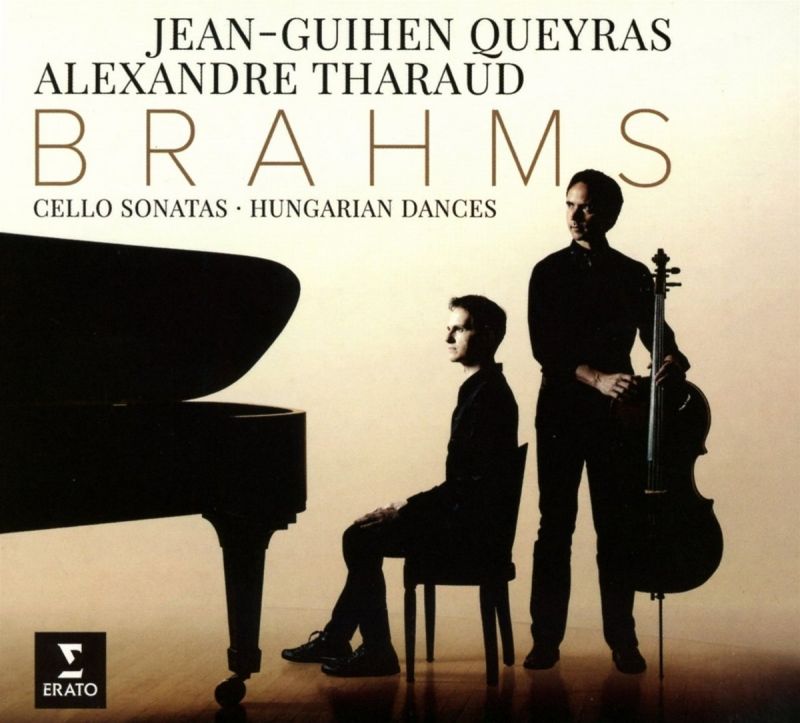BRAHMS Cello Sonatas. Hungarian Dances
View record and artist detailsRecord and Artist Details
Composer or Director: Johannes Brahms
Genre:
Chamber
Label: Erato
Magazine Review Date: 03/2018
Media Format: CD or Download
Media Runtime: 0
Mastering:
DDD
Catalogue Number: 9029 572393

Tracks:
| Composition | Artist Credit |
|---|---|
| Sonata for Cello and Piano No. 1 |
Johannes Brahms, Composer
Alexandre Tharaud, Piano Jean-Guihen Queyras, Cello Johannes Brahms, Composer |
| Sonata for Cello and Piano No. 2 |
Johannes Brahms, Composer
Alexandre Tharaud, Piano Jean-Guihen Queyras, Cello Johannes Brahms, Composer |
| (21) Hungarian Dances, Movement: No. 4 in F minor |
Johannes Brahms, Composer
Alexandre Tharaud, Piano Jean-Guihen Queyras, Cello Johannes Brahms, Composer |
| (21) Hungarian Dances, Movement: No. 1 in G minor |
Johannes Brahms, Composer
Alexandre Tharaud, Piano Jean-Guihen Queyras, Cello Johannes Brahms, Composer |
| (21) Hungarian Dances, Movement: No. 5 in F sharp minor |
Johannes Brahms, Composer
Alexandre Tharaud, Piano Jean-Guihen Queyras, Cello Johannes Brahms, Composer |
| (21) Hungarian Dances, Movement: No. 7 in A |
Johannes Brahms, Composer
Alexandre Tharaud, Piano Jean-Guihen Queyras, Cello Johannes Brahms, Composer |
| (21) Hungarian Dances, Movement: No. 14 in D minor |
Johannes Brahms, Composer
Alexandre Tharaud, Piano Jean-Guihen Queyras, Cello Johannes Brahms, Composer |
| (21) Hungarian Dances, Movement: No. 11 in A minor |
Johannes Brahms, Composer
Alexandre Tharaud, Piano Jean-Guihen Queyras, Cello Johannes Brahms, Composer |
Author: Andrew Farach-Colton
The sense of ease with which Queyras and Tharaud play with tempo is particularly impressive, in fact. They can be quite elastic, slowing down significantly for the coda of the E minor Sonata’s first movement, for example, to give the music a poignant, crepuscular effect. This is managed with utter naturalness, so it not only makes sense but sounds right. In the first movement of the F major Sonata, they quite subtly bend and shape the rhythms, heightening the feeling of passionate yearning – listen, for instance, to the sense of improvisatory freedom beginning at 1'02".
Not all Queyras and Tharaud’s musical decisions are wholly convincing. They move awkwardly in the Allegretto quasi menuetto of Op 38 – like a couple whose attempts at graceful dancing are impinged by overly starched clothing – while the finale is a shade fast, more two-beats-to-a-bar than four, and almost loses its balance on occasion. I also wish they’d observe the mezza voce markings in the third movement of Op 99, as indicated; Starck and Eschenbach demonstrate how these dynamic shadings enhance the drama. On the other hand, they make the Adagio affettuoso of the Second Sonata into something like a spiritual journey of the heart.
The recording pushes the piano to the back of the sound stage. It’s not the most natural balance, admittedly, but it allows us to savour the cellist’s soft-grained tone and expressive attention to detail. The duo’s arrangement of six of Brahms’s Hungarian Dances – played with elegantly plonked dollops of schmaltz and a joyous revelling in virtuoso display – makes this disc pretty much irresistible.
Discover the world's largest classical music catalogue with Presto Music.

Gramophone Digital Club
- Digital Edition
- Digital Archive
- Reviews Database
- Full website access
From £8.75 / month
Subscribe
Gramophone Full Club
- Print Edition
- Digital Edition
- Digital Archive
- Reviews Database
- Full website access
From £11.00 / month
Subscribe
If you are a library, university or other organisation that would be interested in an institutional subscription to Gramophone please click here for further information.




